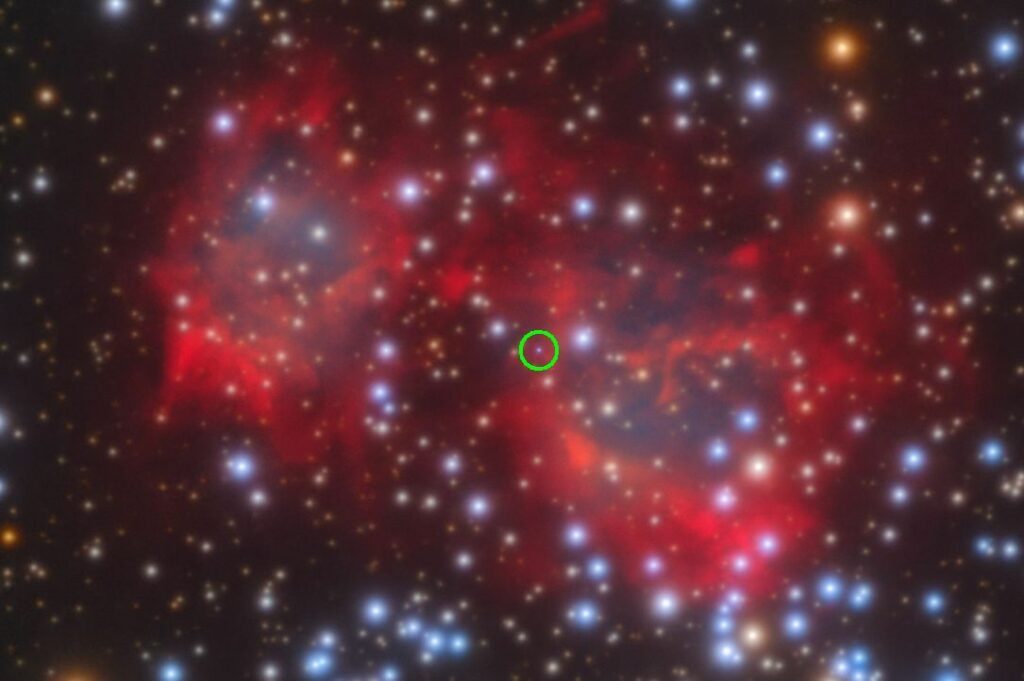Forecasting the Sun’s Destiny: A Deceased Star in the Heart of a Cosmic Cemetery
Scientists examined the planetary nebula within Messier 37 as if it were a celestial mystery, unraveling the enigma surrounding the demise of its central white dwarf star.
For the very first time, astronomers have undertaken an investigation of a lifeless star located within the center of a celestial graveyard, surrounded by similarly aged stellar entities. This stellar relic, a white dwarf, is positioned at the core of a region filled with the remnants of celestial destruction, comprising gases and cosmic debris referred to as a planetary nebula. This intriguing phenomenon is situated within the open star cluster known as Messier 37, positioned approximately 4,500 light years away from Earth.
This comprehensive study not only provides an opportunity to unveil the mysteries surrounding the white dwarf’s demise, akin to an examination of a cosmic crime scene, but it also affords astronomers a glimpse into the future appearance of our own solar system in roughly 5 billion years. When the Sun exhausts its nuclear fusion fuel, it will expand into a red giant, engulfing the inner planets, including Earth, within its expanded outer layers. Subsequently, as the Sun’s shroud of stellar matter disperses and cools, it will transform into a planetary nebula—somewhat misleadingly named, as it has no connection to actual planets. Its core will ultimately evolve into a fading white dwarf.
The butterfly-shaped Messier 37 represents an open cluster of stars that are believed to have originated from the same immense, dense cloud of gas and dust, and they share a similar age. This unique feature enables scientists to gain valuable insights into the evolutionary pathways and demise of stars of the same age but varying masses by studying a deceased star within this cluster. Consequently, open clusters serve as an ideal cosmic laboratory for testing theories related to stellar evolution.
Large stars have a brief but intense existence
Until now, only three open star clusters containing planetary nebulae have been identified by astronomers, and the white dwarf stars situated at the centers of these celestial cemeteries remained unexplored. However, this has changed.
Klaus Werner, who leads the study team and serves as a professor at the University of Tübingen, remarked on the significance of stars in a cluster all being the same age in astrophysics. He explained that more massive stars consume their nuclear fuel, converting hydrogen into helium, at a faster rate, resulting in a shorter lifespan and a more rapid transition into a white dwarf.
One aspect of stellar evolution that remains not completely understood is the rate at which stars shed mass before reaching the white dwarf phase. This relationship between a star’s birth mass and its mass at the end of its life is known as the “initial-final mass relation.” In simpler terms, a white dwarf’s mass can be directly linked to the mass of the star from which it originated. Stars like our Sun lose slightly less than half their mass by the time they become white dwarfs, while stars with a mass eight times that of the Sun shed approximately 80% of their mass. According to Werner, “The data from very young white dwarfs are particularly valuable, as these are the central stars of planetary nebulae.”
Werner also pointed out that none of the central stars of planetary nebulae, now in their deceased state, had been examined previously due to their considerable distance and the faintness of white dwarfs. The team remedied this by directing one of the world’s largest telescopes, the Gran Telescopio Canarias on the island of La Palma in the Canary Islands, toward the celestial graveyard within Messier 37.
Through their observations of the white dwarf’s luminosity, they deduced that it presently possesses approximately 85% of the Sun’s mass. This implies that the star which transformed into this stellar remnant initially had a mass equivalent to 2.8 times that of the Sun. It also signifies, as per Werner’s explanation, that the star lost 70% of its mass throughout its lifetime.

Furthermore, the research team managed to ascertain the chemical composition of the white dwarf within Messier 37, and an intriguing discovery emerged—it conspicuously lacked hydrogen on its surface. This absence suggests that the white dwarf experienced some sort of violent episode in its history, potentially involving a brief surge of nuclear fusion. Such events are known to occur in white dwarfs when they accrete material from a binary companion, drawing it nearer.
A more profound comprehension of the initial-final mass relation is crucial for deciphering a star’s lifespan, as well as predicting its ultimate fate as either a white dwarf, a neutron star, or conceivably a black hole. This relationship can also assist in determining whether a dying star is poised to trigger a supernova, dispersing all the matter it has synthesized over its existence into the cosmos. This ejected material then serves as the fundamental building blocks for future generations of stars.
Werner concluded by emphasizing the pivotal role this process plays in the chemical evolution of galaxies and, ultimately, the entire universe.
The team’s research was published on Oct. 11 in the journal Astronomy & Astrophysics.
This article is republished from SpaceCom under a Creative Commons license. Read the original article.
Do not forget to share your opinion with us to provide you with the best posts !




0 Comments